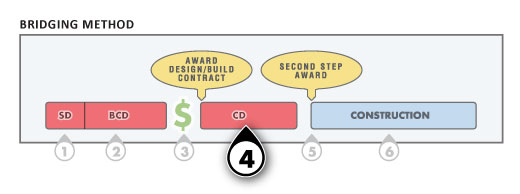Phase 4. During the preparation of the Construction Documents (“CD”) phase the Contractor’s AE completes all detailed engineering design and specifications. Any remaining details of the architectural and site development design are completed in accordance with all applicable codes and fully coordinated these documents. The ODC reviews these documents for full and complete compliance with the BCDs and may reject them if not in conformance. Sometimes, the Contractor’s AE will in fact find that something in the BCDs is not feasible or not in compliance with applicable codes. In that case, the ODC must be reasonable in cooperating to find a solution, but the Contractor (meaning the Contractor and its AE) may not change anything without the ODC’s approval for the change.
On most projects, it is recommended that BIM be employed. Access to BIM should be made fully available to the Contractor’s AE, though with the ODC still having access to all output.
The ODC and Contractor’s AE will probably develop a productive working relationship. However, the ODC should never give a written or verbal approval of these documents, even once they are satisfactorily completed. This is because the Contractor’s AE is either a sub-consultant or employee(s) of the Contractor. In other sub-contracts it is neither wise nor typical for the Owner’s representative to provide final approval on any sub-contract until final acceptance has been given for the full project. Further, there should be no agreement in any of the related documents that directly or indirectly places upon the Owner, the ODC or the Owner’s program manager the requirement for a “detailed technical check and approval” of these documents. Instead, when either a stated grace period expires or the Contractor is either terminated (which is an important right for the Owner) or is authorized to go forward with construction. At that point a progress payment is due to the Contractor (whether the project proceeds or not) for the completion of the Construction Documents. The amount of the payments will be a stipulated amount or a percentage of the Base Bid set by the ODC in the original Form of Proposal. Typically that will run from around 2-4%, varying with the project.
Even after the Construction Documents have been completed and the progress payment for their completion made, the BCDs will remain as the prevailing contract documents with their being supplemented by the completed Construction Documents. Thus, from that point onward, the Owner is entitled to everything called for in either the BCDs or the Construction Documents. If a conflict between the documents is later discovered, the BCDs prevail unless the Owner and the Owner’s ODC approve otherwise in writing. Upon the authorization to the Contractor to proceed in the next step, the BIM output at this point will be “frozen” so that it may remain as a further reference to the applicable contract documents. From this point forward, the Contractor as well as the Contractor’s AE and Subs will be the operators of the BIM system, but access will be available at anytime by the Owner, the ODC and the Owner’s program manager.
Tags: BIM, code, Construction, contractor, documents, phase
